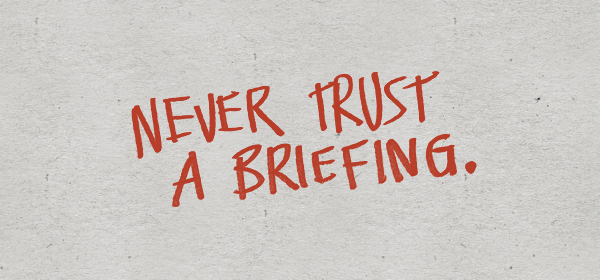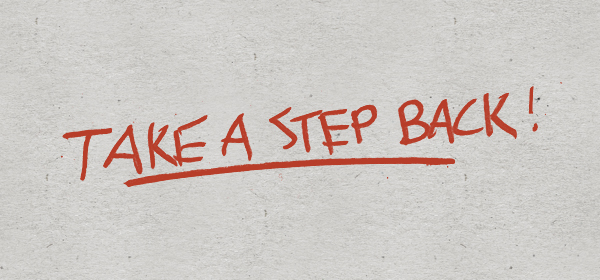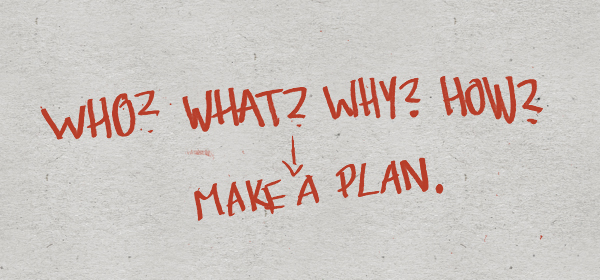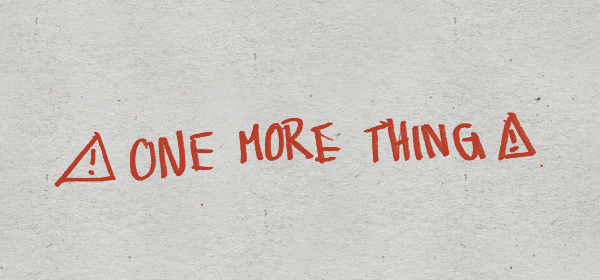Treat a Briefing as a Symptom, Not as a Diagnosis
After discussing how to change the way you position yourself as a designer to stand out and be more valuable to your client, this week I want to take a step more closely into your process and talk about how you should use critical thinking to maximise the value you can create for your clients.

Think about a briefing as symptom, not as a diagnosis
Naturally, a client is going to contact you when they encounter a problem in their business they need a professional for to solve it. Most of the time the client will have a defined goal and some kind of idea of the measures it will take to get to it. In the best cases he will write down his rationale and problem definition and put it together in a briefing. He will send this over to you and expect a scope, price and plan for the project. Right there I want you to stop. What are you doing with this piece of paper now?
We both know enough cases where the initial briefing was not reflecting at all, what the project turned out to be in the end. A lot of designers like to complain about these situations. They blame clients that put together bad briefings. But it is yourself you should be complaining about. If this happens, you did not do your job right. You were not able to solve a problem or reach a goal. You did not care to discover the root problem and you took the briefing for granted. Never trust a briefing. It is not a cure, not even a diagnosis. A briefing is just another symptom of a deeper problem. Treat it like that.

Take a step back and critically examine the briefing
When you receive the briefing this may be in written form (preferably) or happen in a conversation with your client. In both cases, you have to make clear to him that you appreciate the work and will examine it in detail. Explain that you will use the briefing as a starting point of a discovery phase. In this phase you will critically examine the described goals, problems and solutions and come back with your perspective on the project. The goal of this step in the process is your re-briefing.
As a first step take the briefing you got and try to organise it in a few categories:
- Problem description
- Reasons for the problem
- Goal definition
- Proposed measures
This will give you a quick overview of the problem field. Now take a look at each of the points you wrote down. Which of these are observations or “facts” and which are only assumptions. What you have to do now, is gathering more information and uncover the reasoning in your client’s thinking.
For the four categories, there could be a set of questions to ask yourself and your client.
1. Problem description
This part is probably based on observations and facts, but it is always good to get more facts. When did the problem start to occur? How does it affect the business? How did the problem evolve? How much money is your client loosing by it? Why did he come to you for help? Is it a consequence of a business decision or based on external factors?
Really diving deep into the problem description will help you in two ways: First this is your entry point to understanding your client’s business and his struggles. The more you know about his world, the better you will be able to tailor your services to him. The second thing this does is that you might find some red flags or things that don’t add up. You might get the feeling that something else is more problematic than what he thinks. Some problems are a result of a different, deeper problem. Keep that thought when you move on to the next categories.
2. Reasons for the problem
The second step to examine is the reason your client identifies for the problem. It may be a new product, a change in structure or even people within the company. It may be a problem that is rooted in growth or a competitor. Again, it is critical that you listen very well to this. Does the logic end up? What reasons can be tied back to facts and observations, and which are assumptions? Talking about mistakes or strategic problems is not easy for clients, so be open about it. Clarify that you can serve them best, if you understand their situation completely. You would never lie to your doctor either, right?.
3. Goal definition
Next, you should find out what your client identifies as the goal of the project. What is his interpretation of “fixing the problem”? Are there any metrics linked to it? These metrics could be sales or conversion rates. But also consider metrics for brand awareness, stakeholder feedback and other more intangible measurements. A goal does not always have to be tied to a number, since some parts of the value of design are hard to measure. Does the goal the client is proposing make sense for the problem and the reasoning? Are there different goals or metrics that could reflect what you both want to accomplish better?
4. Proposed measures
Most of the time, your client will have a certain idea for the cause of action he wants to go. With all your information on the categories above, now is the moment to bring them all together. Why does your client think this is the way to go? Understand your client’s reasons for the proposed measures. But keep in mind, that it is in your expertise to define these in detail. Ask your client why he came up with those means, if they have considered different approaches and why they have dismissed them. (Remember? What you don’t do matters.) Take all that in and internalise it.
It is time to head to the drawing board and start mapping out your ideas for the possible directions. Take in all this information and combine it with your expertise. After all, you are the professional they hired to find a solution to their problems, not to execute a given plan.

Defining the real problem and a plan of action
When you start out to write your re-briefing, you are doing a lot of different things at once. Besides closely defining the problem and your perspective on it, there are two other goals of the re-briefing: You are establishing yourself as the right expert for this problem and you are aligning your clients’ expectations with your process and approach.
As a rough structure I would consider including these following sections into your re-briefing:
- Business description
- Problem evaluation
- Means and deliverables
- Goals and metrics
You probably noticed that I am not talking about scope, price or timeline at this point. This is all part of the discovery phase, where you find out what the actual job is. Before these points are clearly laid out you should not even start talking about money.
Again a little break-down of what might you might consider in these sections:
1. Business description
To open this up, you want to show that you understood his vision, business model and situation. This will make you credible in talking business. Also any misunderstandings will be visible quickly and you have the possibility to clear things up.
2. Problem evaluation
This section first sums up your client’s input. Then you describe your perspective on the problem. The detail and length of this section highly depends on the briefing you were handed and on the complexities of the problem. If you agree with your clients’ definition this can be pretty short. If you disagree, this will be a bigger chapter.
If your research, analysis and expertise show that the problem is rooted somewhere else, you have to make a case for it. You will put this down in writing in the re-briefing but it is critical to present this to your client in person. Explain your thinking. Describe what you see as the root problem in detail. Make it clear that this is what your experience and the information show you and that you want your client’s ideas on it. If you found a deeper rooted problem, which you can address and your client did not see, this discovery will multiply the value you can create in the project and skyrocket how the client sees you.
3. Means and Deliverables
Now that you did lay out your perspective on the project, it is time to combine those findings with your process and the expectations of the client. Since you should have a process written out (and maybe even openly available your client), he should know about your general process. For the re-briefing you know tailor the general process to the specific requirements on hand.
Show him how your steps help tackle the problem you described earlier. In the end, also describe what you think will be the deliverables. We are not yet talking about scope here, but you can show your client what you think is the right route to go and what he will end up getting.
4. Goals and metrics
Lastly you combine your process with the problem you are trying to solve. Describe what you see as the goal of the project. This may align with the clients’ definition. If you adjusted the problem, it might change a little. Also, you might be proposing different metrics or milestones to measure success. If the problem you started out with was defined as a conversion-problem but your research showed you that it is based on product design for example, the goals you will be focusing on will be vastly different. Your goals may include the initial goals of the client, but they will be a by-product of what you are aiming for.
These four points should be a great foundation to start a re-briefing conversation with your client. He might view some points differently. Hear him out! If his reasoning is solid, you might reconsider your findings. In the case your client is resistant but you are certain your proposition is the right one, this is a red flag. You might have to step away from the project. Your goal is to find out if you both are a right fit, align your mindsets about the project and work towards the best possible solution of the situation.

One more thing
After going so much into depth on what the re-briefing is and how to use it, I want to add one little note here: Your re-briefing is not a sales tool. It is a strategic tool to discover root problems and values, establish your expertise and prevent any wasted time and energy as a result of misaligned expectations and misunderstandings.
Don't use this to up-sell to clients, especially not when they are not in the position to afford it. If you pitch a full rebrand for every flyer you are asked to design, you are abusing and hurting your clients and endangering your credibility. Stay honest, stay humble and be critical towards your client and to yourself.